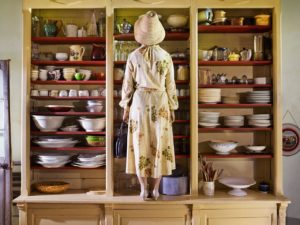The book by Concita de Gregorio “Who am I?” talks about people, about women, about women who have made photography their life, that through photography have understood themselves, their world. Not the world that is absent but their own world. The titles of the chapters are significant. I just try to see myself, Simona Ghizzoni. I ask the photos who I am, Anna di Prospero. Self-portrait is implied. Moira Ricci. The photograph was my analyst Silvia Camporesi. I photograph what I think Guia Besana. These are the five artists of the exhibition but in the book there are plenty of references to others that have worked over time. It is not a catalog of the exhibition, it is a book that starts from the exhibition to analyze the mechanisms of the analysis of the subconscious. As we say at a certain point, the artist, looking at himself, saw something terrible that looks back on us. Because the photo looks at us and concerns us and then questions us, pulls us in and asks us to ask what the artist asked. Who I am?
Dressing up is a way to test other ways of being. Silvia Camporesi in “Esercizi di stile”, 2006, takes various identities inspired by the photos she found. That is not Cindy Sherman’s work on the women of American B-movies, I work on the social, as we said before, that there is not here. It is quite close to the work of Tomoko Savada who in “School Days” builds a picture of a class with 40 pupils and the teacher replicating herself in as many different versions.
Then there is the hiding, closing the eyes. And here too we have a Sophie Calle that holds a hand to cover half the face in the photo made by Jean Baptiste Mondino in 2003. But it is an absolute presence, a being in the world even more intensely with that stern look that attracts on itself, on its own eye all the attention. Instead in the “self-portrait with my family” of 2011 by Anna di Prospero, the mother holds her hands over her daughter’s eyes, which in turn touches her with the affection of the girl who wants to recognize her mother even if she already knows that she is . The mother seems to protect her daughter from the sight of the world that is only a reflection in the glass behind them. And Guia Besana in “Abigail feels lost”, Baby blues 2010 staged the game of hide and seek between mom and daughter thinking about when she was the child and now the mother. While in the photo “Hide with Myself” 2012 Utami Dewi Godjali, through a series of overlays, “portrays herself while watching, looks at you, and holds a child by the hand that points elsewhere”. Simona Ghizzoni wants to hide in the closet where she was hiding from a small am now she is not in it anymore and her legs come out in “Aftermath” 2008.
And then there is double. Natalie N. Abbassi with “Driver and driven” 2011 represents herself on a car. In front of her, she is dressed in the western style, driving and behind her she is wearing a veil. Anna of Prospero in “Self-portrait with my friends” 2011 photographs herself and a friend whose face is not seen, they are both dressed in red, so much so that they could be the same person. In “What do you want from me?” 1928 by Claude Cahun there is she, he, who looks (the artist has always questioned his femininity-masculinity).
In “self-portrait” 1928 apart from the mask that hides the eyes but lets see the little mouth that suits the female figure, the belly is lost and is confused and denied in the background satin because, in the end, is the belly that is the diversity. The mirror has been used and reused by the artists of the 900. Vivian Maier, (she herself says, “I photograph myself to find my place in the world”) is photographed reflected in a shiny knob, in its shadow, in a mirror in moving house, in a shop window.
And then there is the nude. That in the case of Francesca Woodman, “untitled” 1976 is also double because in a squalid room she, naked, sitting on a chair, is reached by her shadow. Simona Ghizzoni in “Aftermath” 2008 is naked with leaves on her back and feels unprotected and vulnerable. Katharina Eleonore Behrend is a pioneer of the nude participating in nudist groups in the early 1900s. In 1908, in “Self-portrait” she emerges from a fleece like the Venus from the shell, its sky is a black drape and the scene widens to show a door and the wall because it does not want to be detached from the context, from the world, it is there because he created a scene in which to stage herself with her absolute femininity. The nude of Helene Amouzou, a refugee from Togo, dissolves into the wall, seems to want to disappear, not be seen, camouflaged. This is her life. And then there is the search, in the water. There are many photos of Elina Brotherus that relates to the water. Here is “The Lake” 2007. The artist is looking back into the water but can not be seen, we do not see the reflection and we do not know what there is. Then in 2012 with “L’Etang” the artist descends into the water up to the ankles and then we always see her back but reflected inside. It is action. Instead Simona Ghizzoni is sitting at the edge of the water of a lake in the middle of which looms the figure of a ruin. It’s a meditation, about who I am, maybe what I see. While Guia Besana takes the place of water that should come down from a slide. Or it is a siren carried ashore between the poseidonia. She wore a tail she had given to her daughter who wanted to be a mermaid. The same artist faces the other fundamental theme that is that of time. In “Untitled # 1 / Me. The hours “2014 takes pictures half an hour away and approaches the two shots. Concita De Gregorio quotes John Berger “The choice is not between photographing x or y: but between photographing at the moment x or at the moment y” and continues “The vocabulary says, the words we use when we talk about images – when we make them. Exposure time, memory, speed of perception and execution. Being there at that moment. Every verb, to stop, to seize, signals an action that competes with time “. And we add the suspension. Many artists have photographed suspended in space and then over time. Natasumi Hayashi in “Today’s Levitation” 29.04.2011. Francesca Woodman in “Untitled” 1977-78. and Silvia Camporesi in “Skywalker, Earthly Indices” 2005, or in “Deep, Down by the Water” 2010. When we go to the psychoanalyst we do a research on time, we dissect it, we look for that moment that was a turning point, a passage, a shock. We are our time. And still the story. Moira Ricci with “A Lidiput” 2003 portrays herself sunk in the sand surrounded by lots of tiny bathers just like Lilliputians. And Gaia Besana in “Avvelenate” 2015 shows us some Snow White dead close to many poisoned apples. From a statistic it results that in Italy we are 60 million and that there are in our homes 60 million animals considered as family. There is also a game based on “what animal are you?”. Well, this is also a way to get to know each other. Simona Ghizzoni photographs a giraffe. She too feels out of scale, out of place.
And then there are the blatant self-portraits, those that slam us in the face of suffering faces like those of Nan Goldin, Graciela Iturbide, Melanie Bonajo while in “Eleonora” Silvia Camporesi, once again, with the bandages on the eyes, takes the parts of a partially sighted person. In the beautiful video trailer we hear the voices of the artists resonate … in your photos of you are both author, subject, and audience … women look at each other, reflect, reflect, split, generate from within … a self-portrait does not necessarily have to be a portrait of myself can be a search for identity through another … great show and great book!
Info:
Istituzione Fondazione Bevilacqua la Masa
Maria Livia Brunelli Home Gallery
Contrasto
“Chi sono io?” Autoritratti, identità,reputazione.
Photography by Simona Ghizzoni, Anna di Prospero, Moira Ricci, Silvia Camporesi, Guia Besana,
Texts by Concita de Gregorio
curated by Maria Livia Brunelli e Alessandra Mauro
December 2 2018 – February 3 2019
 Anna Di Prospero, Self-portrait with Eleonora, 2011, Stampa inkjet fine art, 100×67 cm, edizione di 6 + 2 PA © Anna Di Prospero
Anna Di Prospero, Self-portrait with Eleonora, 2011, Stampa inkjet fine art, 100×67 cm, edizione di 6 + 2 PA © Anna Di Prospero
 Guia Besana, Condition #10 from series UNDER PRESSURE © Guia Besana
Guia Besana, Condition #10 from series UNDER PRESSURE © Guia Besana
 © Moira Ricci, A Lidiput, stampa lambda su plexiglass, 240×60 cm, 2003, courtesy Giovanna Calvenzi/l’artista
© Moira Ricci, A Lidiput, stampa lambda su plexiglass, 240×60 cm, 2003, courtesy Giovanna Calvenzi/l’artista
 Simona Ghizzoni, Series Aftermath, untitled 2008 © Simona Ghizzoni
Simona Ghizzoni, Series Aftermath, untitled 2008 © Simona Ghizzoni
 Silvia Camporesi, Studio per Ofelia, 2004 c-print cm 70×100 © Silvia Camporesi
Silvia Camporesi, Studio per Ofelia, 2004 c-print cm 70×100 © Silvia Camporesi

Emanuele Magri teaches History of Art in Milan. Since 2007 he has been writing abroad for Juliet art Magazine. Since the 1970s he has dealt with writing and visual arts. He created taxonomically defined worlds, in which he experimented with the self-referentiality of language, such as “La Setta delle S’arte” in which ritual clothes are made starting from words with multiple meanings, the “Treaty of genetic art” in which a series of plants is obtained from grafts of human organs, eyes, hands, mouths, etc., and the project “Fandonia”, a city where everything is double and hybrid.







NO COMMENT